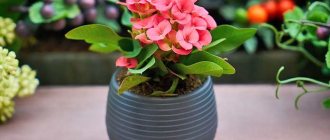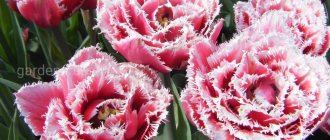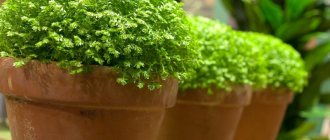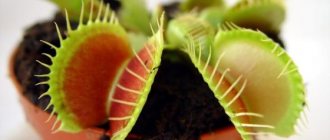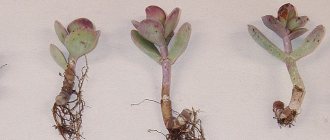Ferns are the most numerous division of higher spore-bearing vascular plants. These are the oldest inhabitants of our planet. No matter how much the climate on Earth has changed, among the huge number of plant species, only ferns have been able to adapt. They have survived to this day, growing in all climatic zones and striking in their diversity. People have long treated ferns in a special way, distinguishing them from other plants. Relict plants of the Mesozoic era, contemporaries of dinosaurs, living fossils - all this can be said about ferns.
Fern - a perennial herbaceous plant from the family of true ferns - has a strong, obliquely growing rhizome with an aboveground stem up to 1 m thick. The rhizome bears a bunch of pinnately dissected leaves. On their lower part there are clusters of sporangia (soruses). Ferns (Polypodiophyta) belong to the oldest groups of higher plants. Ferns belong to the Fern division; there are approximately 12 thousand species of them. In indoor floriculture, in accordance with the accepted systematization, ferns belong to the group of decorative leaf plants.
POTTED FENS
Many decorative species of ferns belong to different classes, orders, and families. Ferns are very widespread; in fact, they grow all over the globe and are found in a wide variety of places. But the greatest diversity of these plants is observed in tropical rainforests. The most commonly grown potted ferns are:
- Adiantum capillus veneris;
- Asplenium bulbiferum;
- Nephrolepis exaltata;
- Golden polypodium (Polypodium aureum);
- Platycerium alcicorr
Where is it used?
Over hundreds of years, layers of fern remains rotted into a peat-like substance, the deposits of which hardened and gradually turned into coal.
Today's species serve as habitats for many animals and interact in symbiosis with other plants. Fern is used in many areas of human activity:
- consume edible varieties, especially popular in East Asian countries;
- in medicine, ferns with antispasmodic, antibacterial and antiviral properties are used;
- in agriculture for peat formation and fertilizer production;
- in landscape design and as indoor plants.
The ability of fern to adapt to new living conditions on land and in water distinguishes it favorably from other representatives of the flora. It is valued for its healing qualities and nutritional value. Decorative species are used in landscaping, room decoration, and arrangement of ponds and aquariums.
INTERESTING ABOUT FERNES
The fern itself, due to its physical, biological and chemical composition, is considered a genuine treasure. Fern shoots and rhizomes are used for medicinal purposes. Fern has been used for medicinal purposes since ancient times. The properties of the fern were described by Dioscorides, Pliny, Avicenna and others. According to its chemical and biological composition, the fern belongs to radioprotector plants, healers and elixirs. It contains 18 valuable amino acids: fructose, sucrose, glucose, arabinose, fiber, ash, protein and amine nitrogen, 40% starch, alkaloids, essential oils, tannins and orec-tannic acid.
Scientists have discovered a species of fern that grows well even in the presence of high concentrations of arsenic in the soil. They suggested that this plant, namely Pteris vittata, could be used to cleanse land and water from THIS TOXIC element or its compounds. Scientists have proposed passing water through reservoirs seeded with this type of fern to cleanse it of arsenic.
Most likely, everyone, without exception, is well aware of the story that once a year on Ivan Kupala, on the shortest night of the year, in a deep forest, under a birch tree with three trunks from one root, a fern blooms. Its flower glows like a flame. If you find this flower, you will have good luck in any matter. And the fern flower is protected by its evil spirits, which does not allow it to be taken out of the forest. Unfortunately, this, although beautiful, is just a legend. Ferns do not bloom , but reproduce by spores.
On the underside of the leaves of most ferns there are special structures called sori, which contain sporangia - organs that form spores. And in some types of ferns, spores are located on special modified leaves.
TYPES OF FERNES AND PLACES OF GROWING
When we hear the word “fern,” most of us imagine a pot of unattractive grass. But few people know that ferns have populated all continents, except, of course, Antarctica, and they feel great in any conditions.
Tree-like giant ferns, liana ferns, and epiphytic ferns grow in tropical forests. Epiphytes are plants that grow on other plants, mainly on tree branches and trunks, as well as on leaves (epiphylls), and obtain the necessary nutrients from the environment, but not from the host plant. That is, in no case should one confuse epiphytic plants and parasitic plants. In the process of evolution, some epiphytes have developed special adaptations for capturing water and minerals from the air. These are, for example, spongy covers on the roots, or so-called root nests - plexuses of roots in the form of a basket in which dust and fallen leaves accumulate and thus create soil for feeding roots. A similar adaptation is found in the Asplenium fern . Other epiphytes, such as the Platicerium fern , have so-called niche leaves that form a niche on the trunk in which soil is also created.
Asplenium nidus
There are giant ferns, for example, Asplenium nidus. This plant is a typical epiphyte, native to tropical Asia. Ferns grow on the trunks of large trees. Reaching enormous sizes (diameter - several meters, and weight - up to a ton or more), asplenium breaks even gigantic trees with its weight. We know aspleniums as ordinary indoor plants, whose sizes are much more modest.
Among ferns there are species that live under water, for example, Marsilea quadrifolia . This fern is often used to decorate small ponds on the site, as the appearance is very decorative.
marsilea quadrifolia
Salviniaceae family is most famous here . These plants can be called weeds of tropical rivers. Reproducing in huge quantities, salvinia becomes an obstacle to water transport, interferes with the normal operation of hydroelectric power stations, and clogs fishing nets.
Salviniaceae
Azola caroliniana
Another floating fern is Azol a caroliniana , grown in rice fields. This plant has a unique ability to accumulate nitrogen, in addition, Azola suppresses the growth of weeds in rice plantations.
Among the ferns, there are dwarf ferns that are only a few millimeters long. These microscopic plants grow in tropical forests on the surface of stones or the ground, rising to a small height along tree trunks. Among the ferns there are real “trees” - the genus Cyathea , whose height reaches 25 meters, and the trunk diameter reaches half a meter.
Fern genus Cyathea
There are ferns whose leaf petioles can rival steel in strength - Dicranopteris . You can get through the thickets of Dicranopteris only by working hard with a machete, on the blade of which the fern leaves marks, as if cutting real metal wire.
Dicranopteris
Growing ferns indoors became fashionable in the 18th century. At that time, ferns could be seen in elite English salons; they were decorations of expensive hotels and houses of noble people. However, only a few species were grown as ordinary houseplants, because gas combustion products and smoke from coal, which was then used for heating, are extremely poisonous to almost all ferns. Then the British came up with special “fern showcases” (glass boxes framed with cast iron) for ferns, which maintained the necessary air and soil humidity.
Flower growers became interested in ferns at the beginning of the 19th century. In Europe, they planted gardens and parks and decorated picturesque shady corners near water bodies. Currently, ferns are highly valued by both professional and amateur gardeners all over the world. For example, in Germany there is a whole network of greenhouses that specialize exclusively in the cultivation and sale of ferns, the leaves of which are then used in making bouquets and various flower arrangements.
It is believed that more than two thousand species of ferns are now suitable for growing indoors. But despite this, resistant cultures of more than four hundred species of ferns have been bred in greenhouses and greenhouses of botanical gardens.
There is no consensus among professionals as to whether these plants are difficult or easy to grow. But one thing is for sure: ferns require constant care.
STRUCTURE OF FENS
Ferns (Polypodiophyta) are a division of higher plants occupying an intermediate position between rhinophytes and gymnosperms. Ferns differ from rhiniophytes mainly by the presence of roots and leaves, and from gymnosperms - by the absence of villages. Ferns originated from rhiniophytes, to which the oldest Devonian ferns were very close. Some of the most primitive genera were intermediate forms between rhyniophytes and typical ferns). Ferns, like other higher plants, are characterized by an alternation of generations - asexual (sporophyte) and sexual (gameophyte), with the dominance of the asexual generation.
Fern sporophyte is a herbaceous or tree-like plant, mostly with large, repeatedly dissected leaves (young leaves are usually snail-shaped). Ferns are characterized by a wide variety of shapes, internal structures and sizes. Their leaves vary from multiple pinnately dissected to whole, from gigantic - 5-6 m long (in some representatives of Marattia and Cyathea) and even up to 30 m (curly leaves in Lygodiu articulatum) to tiny leaves only 3-4 mm long, consisting of 1 layer cells (in Trichomanes goebelianu). The length of the stems of ferns varies from a few centimeters to 20-25 m (in some species of Cyathea). They are underground (rhizomes) and aboveground, erect and climbing, simple and branched. In most sporangia are located on ordinary green leaves; some leaves are differentiated into spore-bearing (sporophylls) and vegetative, green.
Most ferns are homosporous. Among modern ferns, only three small families of aquatic ferns are heterosporous: Marsileaaceae, Salviniaceae and Azollaceae.
Plant life cycle
Reproduction of ferns - diagram and description
The life cycle of a flower consists of sexual and asexual periods, which alternately replace each other, for which the fern needs spore-bearing and fertilizing shoots; they have differences in structure. The sporophyte, which is more commonly understood as a green leaf-shaped stem, is asexual. On its underside, sporangia ripen, which contain spores for plant propagation. They look like small dark tubercles on the leaves - sporophylls.
From thousands of spores that have fallen to the ground, a gametophyte grows - a small rounded sprout, which is characterized by its small size, up to 6 mm. The reproductive organs develop in it - male (antheridia) and female (archegonia). After maturation, the male reproductive cells fertilize the female ones. A new sporophyte grows from the embryo, which will produce new spores to continue the life of the plant.
Life cycle of a fern
